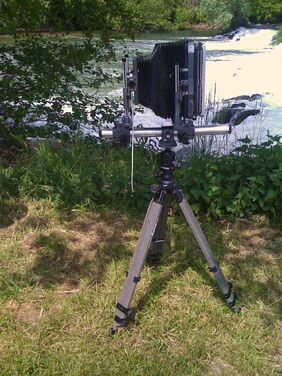
A Plaubel Peco Profia 8 x 10 view camera at work in southwestern France
The Plaubel Peco Profia series consists of various sizes of bellows-type metal view cameras built on optical bench tubular monorails. The sizes include both metric film formats and U.S. formats, so film backs must be carefully specified. The camera design features four distinctive posts, two suspending the front standard between them, and two suspending the rear standard. The posts are connected by a cross-bar which in turn is connected to the monorail. The pleated bellows are interchangeable with optional soft wide-angle bellows or extra-long pleated bellows. Both front and rear standards have a full range of tilt, shift, swing, rise and fall movements.
The first generation of Peco Profia cameras emerged between 1967 and 1968, including three metric formats ( 9 x 12, 13 x 18, and 18 x 24 [cm] ) and three U.S. sizes ( 4 x 5, 5 x 7, and 8 x 10 [inches] ). There are three models of the smallest format ( "V", "N" and "Z"), three models of the middle format (again, V, N and Z), and two models of the largest format (N and Z). The lower-priced "V" models use a square-shaped monorail. Each model is somewhat different from the others, especially in price. A 1976 price list started at 972 DM (Deutschmark) for the basic 9 x 12 "V" model (without lens or shutter, of course) and rose to 2,045 DM for the 9 x 12 "Z" model with extendable monorail. The largest camera, 18 x 24 cm, was naturally more expensive: in 1976 the "N" model was listed at 2,647 DM, while the top-of-the-line "Z" model cost 3,168 DM including lens and shutter.
The latest Profia generation came out a few years ago and includes a new 6 cm x 9 cm model, Peco Profia PL69D, designed specifically for digital photography in the 6 cm x 9 cm ( 2-1/4" x 3-1/4" ) format but still fine for analog film photography on 120 roll-film. It weighs almost three times that of its little ancestor, even without the digital adapter. It also looks much different from the older Profias because it uses L-shaped front and rear standard supports instead of the conventional U-shape supports, but it is still built on a tubular monorail. The Plaubel Digital Adapter PL69 is an option (and it's not cheap). The basic camera, without lens, shutter, or even a lens board, was listed at 4,150 Euros in 2012, while the digital adapter listed at another 1,420 Euros and includes certain other adapter plates. There is also a Plaubel Digital Adapter PL70 for professional 4 x 5 cameras; it carries the same price. Another new camera, the Peco Profia 1, is a 9 cm x 12 cm ( 4 x 5 ) bellows monorail which, like the PL69D, uses two L-shaped supports to carry the front and rear standards. Plaubel's product description does not mention a digital capability although the 4 x 5 Plaubel Digital Adapter would indicate it could perform as such. The PL 1 weighs a hefty 12 pounds (5.8 kg) stripped and is listed at 2,375 Euros. Both cameras feature zero indices for adjustable components and precision focusing drives.
Two other recent Peco Profia series are the NT and ZT models; each available in the three usual metric formats and three US formats. These monorail view cameras are equipped with the more conventional U-shaped supports for the front and rear standards. The ZT series is the pricier, ranging from 2,475 Euros for the 9 x 12 cm ( 4 x 5 ) version to 4,205 Euros for the 18 x 24 cm ( 8 x 10 ) model which tops the weight scale at 16.5 pounds (7.9 kg) stripped. The ZT Profia series has precision drives. Both NT and ZT cameras use friction drives for focusing.